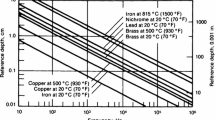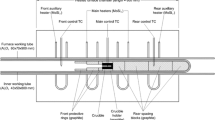Abstract
In CCT documents it is stated that “...for the freezing curves of the metallic fixed points, the maximum observed temperature on the plateau should be taken as the best approximation of the liquidus temperature. The fixed points should be realized with the inner and outer liquid-solid interfaces and extend past the maximum by 10 % to 20 % of the fraction frozen, to clearly establish the value of the maximum and the resolution of its determination.” Also, it is accepted that “...the inner interface is essentially static. It is the temperature of the inner liquid/solid interface that is measured by the thermometer.” The analysis of freezing curves obtained by the standard method of fixed-point realization shows that the parameters of the initial part of the freezing curve, the mean temperature value of which is usually taken as the liquidus temperature, depend on how the inner interface is initiated. Variations in the duration and intensity of initiation cause changes in the initial part of the freezing curve and in the resulting SPRT measurement. Moreover, the relation between the duration of the initial section of the plateau with a minor temperature change and the duration of its final section with a significant slope also depend on the initiation method used and on the furnace temperature. The effect of freezing initiation conditions on the measurement result is individual for each fixed point because of the differences in thermophysical properties of metals and in conditions of the heat transfer from the liquid–solid interface to the thermometer. Aluminum has a maximum value of the melting specific heat in comparison with other metals used in ITS-90 fixed points; in the present study, the effect of the intensity and duration of the inner liquid–solid interface initiation was investigated both experimentally and through calculation.
Similar content being viewed by others
References
E.H. McLaren, in Temperature: Its Measurement and Control in Science and Industry, vol. 3, ed. by C.M. Herzfeld (Reinhold, New York, 1962), pp. 185–198
Quinn T.J.: Temperature, 2nd edn. Academic Press, London (1990)
H. Preston-Thomas, P. Blombergen, T.J. Quinn, Supplementary Information for International Temperature Scale of 1990 (BIPM, 1990)
B.W. Mangum, P. Blombergen, M. Chattle, B. Felmuth, P. Marcarino, A.I. Pokhodun, Working Documents of the 20th Meeting of the Consultative Committee for Thermometry, BIPM Document CCT/2000-13
Weinberg F., McLaren E.H.: Trans. Metall. Soc. AIME 227, 112 (1963)
Baveja K.D.: Res. Ind. 30, 489 (1985)
A.G. Ivanova, A.I. Pokhodun, Com. Cons. Thermometrie, BIPM Document CCT/89-2
Lee H.K., Gam K.S., Rhee C.: Metrologia 28, 413 (1991)
Ivanova A.G., Il’in A.Yu.: Meas. Tech. 47, 1096 (2004)
Widiatmo J.V., Yarada K., Yamazawa K., Arai M.: Metrologia 43, 561 (2006)
Author information
Authors and Affiliations
Corresponding author
Rights and permissions
About this article
Cite this article
Abasov, M.Y., Gerasimov, S.F., Ivanova, A.G. et al. Measurement of Al Freezing-Point Temperature: Effect of Initiation Process. Int J Thermophys 31, 1663–1675 (2010). https://doi.org/10.1007/s10765-010-0815-8
Received:
Accepted:
Published:
Issue Date:
DOI: https://doi.org/10.1007/s10765-010-0815-8




